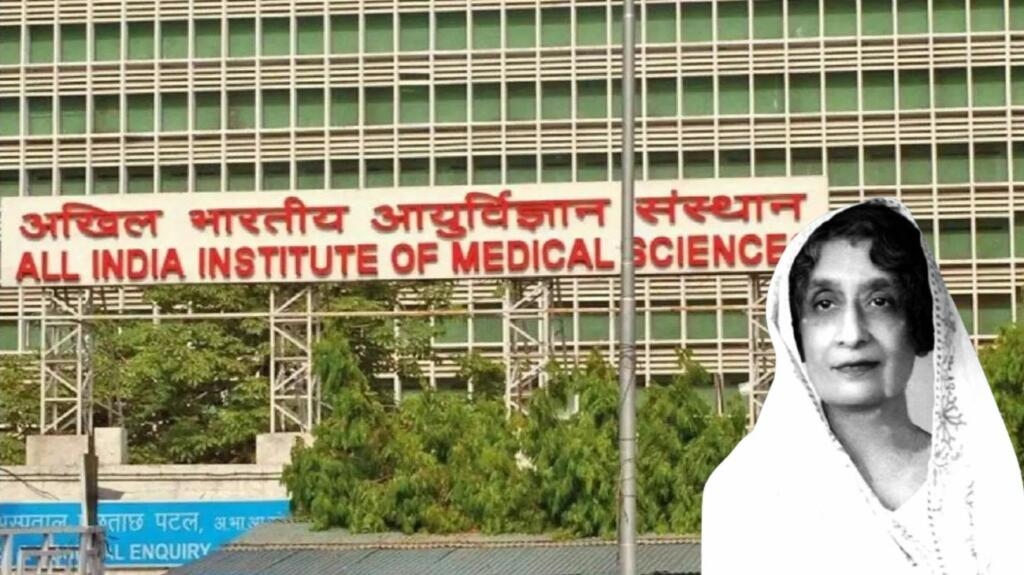The Constitution of India guarantees equality and signifies that no discrimination should be practiced on any basis. The institution firmly standing up with these constitutional values is the All India Institute of Medical Sciences (AIIMS). AIIMS, as an institution, is serving the people without any discrimination since the day it was built.
Often, the credit for winning a battle goes to the king and people forget about the major role played by ‘Senapati’ without whom the battle was unwinnable. Jawaharlal Nehru is credited for giving the people an institution like AIIMS. But the pivotal role played by the then Health Minister Rajkumari Amrit Kaur is ignored widely.
AIIMS: An Institution
The foundation of AIIMS we see today was laid by Rajkumari Amrit Kaur in the 1950s. Rajkumari Amrit Kaur not only initiated the construction of AIIMS but also incorporated some values that make it different from others. AIIMS treats every patient equally. It does not provide VIP treatment to the rich nor does it make the poor stand in line.
AIIMS has some other outstanding features as well. In first of a kind, AIIMS does not allow any kind of private practice to doctors. The doctors practicing in AIIMS are expected to devote their valuable time only to the patients of AIIMS Hospital. AIIMS doctors are not constrained to the treatment of patients only, but they also teach and perform research. AIIMS also houses its staff and students within their campus. This close proximity helps in delivering better results.
Also Read: Modi government’s war on future pandemics is here
How AIIMS was built: The Timeline
Till now, we know who played a pivotal role in the construction of AIIMS. Now, let’s understand how AIIMS came into existence.
Government of India’s Health Survey in 1946 insisted on the importance of a central medical institution for postgraduate education and research purposes. The bill to create the same was tabled in Lok Sabha by then health minister Rajkumari Amrit Kaur in February, which was cleared by May. But this did not guarantee the construction, as funds were a problem.
The idea of a central medical institution had to wait another 10 years since it was first recommended. Rajkumari Amrit Kaur rallied around different countries of the world and brought in investments. The countries that agreed to invest in the idea were New Zealand, Australia, Germany, and the Netherlands. Rajkumari also garnered the support of some international organizations like the Ford Foundation.
AIIMS took its first admission in 1956. And by 1961, it attained global repute.
The woman behind AIIMS: Rajkumari Amrit Kaur
The Lutyens media and our history books have fed the propaganda that ‘Nehru built AIIMS’. Though Nehru was the prime minister of India, the driving force behind the foundation of AIIMS was a woman. A health minister whose credit is due since forever. A woman who was a princess, a freedom fighter, and a social reformer. A woman of many firsts, Rajkumari Amrit Kaur.
Rajkumari Amrit Kaur as the address suggests, was the princess of the Kapurthala princely state. She was born in 1889 as Protestant Christian to Raja Harnam Singh and Priscilla. Despite being brought up as a Protestant Christian, she was a patriot and criticized Christian missionaries for alienating the Indians and drawing them away from their own culture.
Kaur was an Oxford graduate and completed her study abroad. After completing her education, she returned to India and immediately gained interest in the Independence struggle. She started getting involved in social reforms and waged a war against regressive practices like the purdah system, child marriage etc. In 1927, she founded the All-India Women’s Conference to make her fight for women rights stronger.
In 1930, she joined the nationalist movement and advocated for the participation of women in the freedom battle. She was later elected to the Constituent Assembly where she stood for Uniform Civil Code alongside KM Munshi, Minu Masani and Hansa Mehta. She advocated that a uniform civil code is necessary to counter the discriminatory practices in different religions like the purdah system, polygamy, inheritance practices among others.
Also Read: Digvijaya Singh dug up some questionable pics of Nehru and brutally trolled him
She was inducted into the Union Cabinet though, she was not the first choice of Nehru, as she had been a critic of Congressmen now and then. She carried out her responsibilities so well that after more than 100 years of her birth she was listed by TIME magazine as the woman of the year in 2021.
